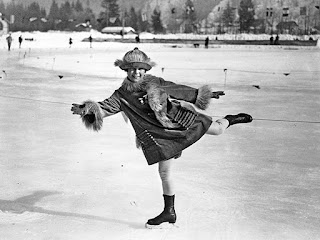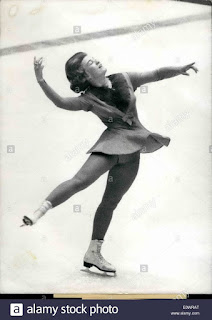Henie was a mere 11 years old for her first Olympics in Chamonix in 1924. She skated in a fur-trimmed coat over woolen leggings with a fur hat and heavy gloves.
The medalists in 1924 were, from left to right above, Herma Planck-Szabo of Hungary (gold), Ethel Muckelt of Britain (bronze), and Beatrix Loughran of the US (silver). All three dresses would have looked perfectly at home in any crowd on the street, and were accessorized by heavy black tights, gloves, and pert hats.
Henie won gold at the next three Olympics, starting in 1928 in St. Moritz. Already the costumes had developed a distinctive "skater" look. Skirts were well above the knee and trimmed with fur to emphasize how they flared out during spins. This was definitely NOT a look you'd expect to see on the street.
At the 1932 Lake Placid Olympics, Henie lost the fur trim but kept the pert hat and flared skirt. Thick leggings and gloves helped for both warmth and modesty.
Winning the gold again in 1936 in Garmisch-Partenkirchen, Henie dropped the hat and the heavy leggings but kept the short, full skirt and demure bodice. Again, there was very little trim other than a thin edge of fur at the hem of the skirt and the sleeves.
Once Henie retired, Canadian Barbara Ann Scott stepped up to take gold at the 1948 St. Moritz Games. Scott wore another plain skater dress, although noticeably shorter and slightly less full than Henie's Olympic outfits, but still with a demure and simple bodice with no embellishments. She paired it with a white cashmere bonnet.
Jeanette Altwegg of Great Britain, who had taken home the bronze medal in 1948, struck gold in the 1952 Oslo Games. Her dress was significantly flashier than past years, being made of shiny print fabric with a short, pleated skirt and flower detailing at the neckline.
In 1956, another previous medalist moved upwards on the podium, as American Tenley Albright added a gold medal from Cortina to her silver from Oslo. Albright's dress was a vivid pink with a leotard-style base and a very short tutu-style skirt. This would be the basic style we would see for many years so come.
In 1960, Carol Heiss was the next previous silver medalist to step up to the top spot on the podium, winning gold at the Squaw Valley Games in a short-skirted dress with fringed white trim and a ruffled yoke, with matching headband.
For the third Olympics in a row, the previous silver medalist advanced to the gold medal spot, as the Netherlands' Sjoukje Dijkstra became the 1964 Olympic champion in Innsbruck. Similar to Heiss' dress, Dijkstra wore a short-skirted dress with a v-shaped insert.
Peggy Fleming brought the gold medal back to the US at the 1968 Games in Grenoble, in a pale green dress with just a touch of white lace at the neck and wrists. Pretty, but ho-hum.
The 1972 Sapporo games finally brought a hint of personality to the skaters' dresses. Gold medalist Beatrix Schuba of Austria (above center) wore a crotch-skimming, jacket-styled dress without a separate skirt, with white sequin details at the edge of the lapels and the bottom of the jacket. Canada's Karen Magnussen wore a more traditional red dress but added large white flowers to the bodice as she took home the silver medal, and American Janet Lynn opted for a simple rose pink dress with a barely-there, unflared skirt.
The only thing more iconic at the 1976 Innsbruck Games than Dorothy Hamill's haircut was her pair of matching red and hot pink dresses. Although keeping a similar silhouette to past years, Hamill's dress featured a lowered neckline (with a modesty panel) trimmed with white sequins.
We finally started to see some more overall spangles and sequins at the 1980 Lake Placid Games, as Anett Potzsch of East Germany took home the gold in a bright blue dress with a cascade of silver sequins across the front.
1980 silver medalist Linda Fratianne of the US also wore a dress with spangles all over, hers in vivid red. Both skaters wore long sleeves but deep scoop necks.
The 1984 Sarajevo Games saw a huge step forward in style, thanks in large part to gold medalist Katarina Witt of East Germany. Witt's deep rose dress with flames running down the front and the sleeves looked more revealing than it was.
The 1984 silver medalist, American Rosalyn Sumners, was downright demure compared to Witt, in her simple white dress with blue leaves down the front and silver spangles covering the modesty panel.
In 1988, Witt sported this vivid blue showgirl number decorated with silver sequins and feathers, including feathers at the hips in lieu of a skirt. This outfit inspired a new rule, dubbed the "Katarina Rule": Costumes were now required to cover "the hips and posterior" and bare midriffs were banned. (The rule was canned in 2003.)
Thomas also caused a fashion flap that year by wearing a unitard rather than a dress for one of her performances. The International Skating Union responded with a rule that female skaters must wear a skirt, a rule which was repealed in 2004.
The 1992 Albertville Games were famous for their contrast of graceful artistry vs. strength and athleticism. American gold medalist Kristi Yamaguchi (above, top) and American bronze medalist Nancy Kerrigan (above, third) were known for their elegance and long lines, while Japanese silver medalist Midori Ito (above, second) and American Tonya Harding were known for their jumping ability and physical strength. Yamaguchi and Kerrigan chose dresses with graceful, fluttery skirts, Yamaguchi's in black with gold detailing on the bodice and Kerrigan in pure white (her trademark color) with a sheer yoke. Ito wore a traditional style with a skirt that was higher at the hips, in cranberry with white detailing, and Harding wore a sleeveless white dress with carwash skirt and gold spangled snowflakes on the front. An interesting mix of old and new styles.
The 1994 Lillehammer gold medalist, Oksana Baiul of Ukraine, became famous for her ballet-inspired costumes. One costume was bright shades of pink with vivid pink marabou trim; another was sleeveless black with spangles and an elaborate feather headdress and skirt.
Harding and Kerrigan were both back in 1994, when the battle or grace vs. strength turned into a physical attack on Kerrigan, who recovered enough to take home the silver. Similar to the previous Olympics, Harding wore a brightly colored, spangled, sleeveless dress with a full skirt, while Kerrigan donned an elegant champagne colored outfit with sheer sleeves, a high neck, and a slim skirt - incidentally, created for her by designer Vera Wang.
The 1998 Nagano Games saw more bare arms and less traditional silhouettes. 15-year-old American Tara Lipinski took home the gold in a cobalt blue halter dress with silver trim and a frontless skirt, while teammate Michelle Kwan won silver in a simple periwinkle velvet tunic-style dress with spaghetti straps.
The 2002 Salt Lake City Games saw a continuation of the trend of bare arms and slimmer skirts, with American Sarah Hughes taking home the gold in a pale lavender sleeveless dress with a lace top and a relatively straight skirt.
In contrast, 2002 silver medalist Irina Slutskaya of Russia wore a more traditional black, long-sleeved dress with silver spangles and a longer but sheer skirt.
Michelle Kwan won the bronze medal, wearing a Arabian-themed cranberry dress with gold trim evocative of her music, "Scheherazade," and a purple dress with gold trim and a narrow skirt.
The 2006 Torino Games saw even more diversity of style. Gold medalist Shizuka Arakawa of Japan wore a daring blue and aqua wrap outfit with a plunging neckline and an asymmetrical skirt; silver medalist Sasha Cohen of the US wore a plunging blue sleeveless top and a scarf-style wrapped floral skirt; and Slutskaya dropped back to bronze, wearing a red dress with silver and black trim and revealing sheer black panels along the sides.
The 2010 gold medalist in Vancouver was South Korean Kim Yuna, who wore a bright blue halter dress with empire waist and semi-sheer skirt, with a heavily spangled bodice and neckline.
Silver medalist Mao Asada of Japan wore two different red and black outfits, each with long sleeves, a scoop neck, a neckband, and a full, sheer skirt, both with embellishments including feathers, sequins, and ruffles. Asada also wore black gloves with one dress.
Bronze medalist Joannie Rochette of Canada took full advantage of the repeal of the "Katarina rule" in this aqua halter with plunging neckline and bare midriff, with plenty of gold sequins all over.
2014 gold medalist Adelina Sotnikova of Russia wore several outfits that harkened back to Michelle Kwan's simple tank dresses, one in red with metallic gold patches and one in gray with black geometric lines.
Yuna slipped back to the silver medal position at the Sochi Games, although her outfits stepped up her fashion game. She sported a striking yellow dress with fluttering chiffon bell sleeves and skirt and a bodice encrusted with silver sparkles, and also an asymmetrical, form-fitting black and magenta slim-cut dress with silver embroidery.
Carolina Kostner won the bronze in a rare showing for Italy on the figure skating podium. She held up her country's reputation as a cutting-edge couture capital in a black dress with barely-there skirt and lots of sheer panels; and another with an ice-blue leotard covered by a sheer white dress with plunging neckline. Costner is considered a medal contender in 2018.
The 2018 women's figure skating events have yet to happen, but here are some women to keep an eye on (for both medals and fashion):
Medvedeva's teammate and rival, Alina Zagitova, won this year's European championships. Her looks tend to be cutting edge but still traditional, such as her aqua dress with built-in gloves, strapless red tutu dress with elbow-length gloves, and black and white swirled long-sleeved dress with tutu skirt. Her looks will be worth watching for.
Canadian teammates Kaetlyn Osmond (first two photos above) and Gabrielle Daleman (last two photos above) both have daring styles. Osmond varies her silhouettes, from a cinched-in, wide-sashed dress paired with a neck scarf and gloves to a straight-cut tank dress with side slits. Daleman's style is somewhat more traditional, although she doesn't shy away from a single sleeve or a plunging neckline - and she's clearly fond of spangles. VERY fond.
Japan also has two contenders on their Olympic team: Satoko Miyahara (top two photos, above) and Kaori Sakamoto (bottom two photos, above). Miyahara is the more traditional of the two, wearing long sleeves and traditional cuts. Sakamoto is not afraid of unusual silhouettes, asymmetrical lines, or bare skin.
Here's to seeing some beautiful outfits and some even more beautiful skating this week!




































































No comments:
Post a Comment